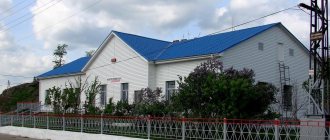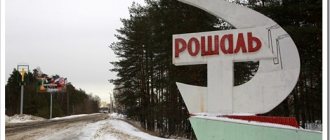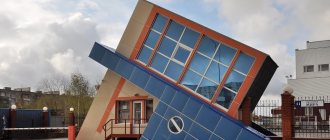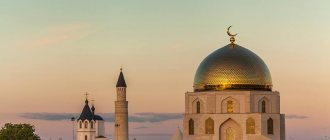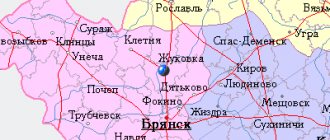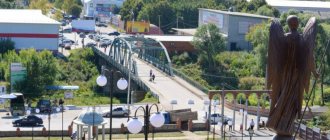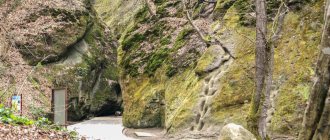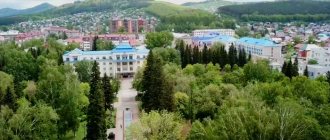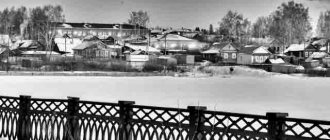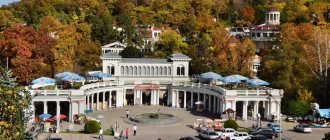The Tver region is located just 90 km from Moscow and is one of the most attractive Russian territories with a rich historical past for fans of their native history. It is in 38th place in size with an area of 84,201 km² and in the same position in terms of population: 1,269,182 people live here. The population density is low - 15.07 people/km². Despite the fact that this is almost twice the national average, on the other hand, the figure is more than ten times less than in the Moscow region and two times lower than in the Penza region. There are few cities in the region - only 23, but they are home to 76.5% of the total number of residents of the region.
The largest cities in the Tver region by population
There is not a single million-plus population in the Tver region. The most densely populated area is the capital of the region - Tver, where 420,065 people live. In other cities, the number of residents does not even reach 100,000, and in eight of them it is less than 10,000. Since 1989, the number has been steadily falling: over 30 years it has decreased by more than by 400,000.
The most populous cities in the Tver region include:
- Tver - 420 065.
- Rzhev - 59,422.
- Vyshny Volochek - 46,908.
- Torzhok - 45,641.
- Kimry - 44,743.
- Konakovo - 38,486.
- Udomlya - 28,119.
- Bezhetsk - 21,179.
- Bologoe - 21,158.
- Nelidovo - 18,883.
Famous people
- A participant in the Patriotic War of 1812, General A. N. Seslavin, was born in the village of Yesemovo.
- In the village Klepenino (not preserved) - the family estate of the Obruchevs and a model agricultural estate in Russia, created by I.M. Sechenov and his wife Maria Alexandrovna who lived there, the famous Soviet geologist and writer V.A. Obruchev was born and raised.
- N.V. Gogol and A.N. Ostrovsky visited Rzhevsky district.
- General A. A. Ignatiev grew up in the Znamenskoye estate.
- General L.D. Vasilevsky was born and raised in the Prudki estate.
- The choral conductor, composer, People's Artist of the USSR (1980) Meshko, Nina Konstantinovna (1917-2008) was born in the village of Malakhovo.
Rzhevsky district is the birthplace of Heroes of the Soviet Union: V. S. Aleksandrovsky, V. D. Balashov, I. P. Zhuravlev, I. P. Zrelov, A. K. Konstantinov, V. N. Kubarev, D. S. Molodtsov, F. Ya. Morozov, M. I. Rumyantsev, K. I. Tsaritsyn, V. F. Tsvetkov.
Tver is the leader of the list of the most densely populated
The largest settlement in the region is Tver, a city with a rich history located on the banks of the Volga. It was founded in 1135, a century later it became the center of the powerful Tver Principality and even competed with Moscow for supremacy in the northeastern territories of Ancient Rus'.
Tver has an advantageous geographical location: today, as in past eras, important trade routes intersect here. Now there is a railway line connecting the two capitals, as well as a highway connecting Moscow with the settlements of the Upper Volga basin.
If at the beginning of its development Tver was one of the largest urban formations in the region, by the 17th century it fell into decline due to the Polish-Lithuanian conquest: about one and a half thousand inhabitants lived here. Later the level increased, but the next blow was the invasion of German troops during the Second World War. From 2001 to 2007, the population sharply decreased by almost 40,000, but since 2010 the dynamics have become positive: every year the number of citizens increases by 2,000-3,000. The outflow of the local population to neighboring capitals continues, and the demographic growth in recent years is due to the migration of people from other regions and small settlements in the region.
Today, 420,065 people live on an area of 152.22 km², providing a fairly high population density of 2759.59 people/km². The indicator is two times lower than in Moscow and just as much higher than in Beijing, where it is 1292 people/km².
Since the city cannot be called large, there are no problems associated with overpopulation. Traffic jams mainly occur in the narrow streets of the historical center, especially during the high tourist season. Sometimes there are difficulties on the M10 highway: it is located on the outskirts and connects the region with St. Petersburg and Moscow. Industry is developed, accounting for 39% of the region's total. There are about 50 large enterprises operating in such industries as:
- metal processing;
- mechanical engineering;
- printing;
- energy sector;
- chemical and light industry.
This provides a number of environmental problems associated with air and soil pollution by harmful emissions. However, the situation cannot be called critical: Tver is not among the most polluted in the country.
Interesting Facts
As of 2022, the population density of the Tver region is 2,600 people per 1 sq. km. The city has many areas with one-story buildings, especially in the historical part. During the Soviet period, Tver was actively developing, many factories and large industrial facilities appeared, for example, a thermal power plant, a worsted plant, a pharmaceutical factory and a fiberglass production plant.
After the collapse of the USSR, the population of the Tver region found itself in a difficult situation. The region traditionally specialized in light industry and food products, and after the annexation of the “fraternal” republics, trade turnover fell sharply. Between 1990 and 2000, virtually no construction or improvement work was carried out in the city.
A new life for Tver begins in the mid-2000s, when four high-rise microdistricts appeared on the map. In addition, with the initiative of the mayor, Tver is beginning to hold the largest economic forum in Russia, which gives the region additional dividends.
Rzhev - rebuilt from scratch after the war
The second line of the list is occupied by Rzhev, where there are 59,422 citizens living on an area of 56.17 km². The density here is more than two times lower than that of the leader in the ranking and is only 1057.9 people/km². On the other hand, it is just as high as in Venice, where the figure remains at 629 people/km². And, if hundreds of thousands of tourists flock to the capital of canals and bridges every year, creating traffic and crowds on the streets, Rzhev cannot boast of such popularity.
Already in the 18th century, Rzhev was considered an important center of economy and industry, where about 25 industries and many trading companies operated, had its own guest court and hosted large fairs. Before the Great Patriotic War, 56,000 people lived here, about 20,000 fell into occupation. After the liberation of the city, only 156 Rzhevites remained alive, and the number of surviving houses was 297. In one of the bloodiest battles, Rzhevskaya, about a million Soviet soldiers died. Tragic events forever changed the fate of the city: after the war it was rebuilt, by 1959 48,971 lived here. Today the city is an important logistics hub, and also has industrial enterprises operating in nine regions. The tourism sector is poorly developed, since most of the ancient monuments were destroyed during the war.
With faith through the horrors of the hard times of war
March 3, 2014 marks the 71st anniversary of the liberation of the city of Rzhev from the Nazi invaders. Last year, on the 70th anniversary of the liberation of the city, a memorial plaque was installed on the wall of the Old Believer Church of the Intercession. Currently, unique memoirs of eyewitnesses of those events, letters, and diary notes of prisoners of the mined Intercession Church have been found in the archives. Perhaps no one except the witnesses of the hard times of war can tell us better about the events that they had to endure. No historical information, figures, documents will tell us so realistically and vitally about the military Rzhev. Today, the memoirs of Matryona Alexandrovna Tikhomirova, the mother of deacon Theodot Tikhomirov, who served in the Trinity Church of Rzhev, which was closed before the war, and then in the Church of the Intercession, are published. On March 1, 1943, Deacon Theodot and Mother Matryona, together with the remaining residents of the city, found themselves prisoners of a mined church...
Vyshny Volochek - large, but steadily decreasing
Vyshny Volochek, located 300 km from Moscow and 119 km from Tver, closes the top three. The density index here is even lower - 868.67, so there are no congestion or crowded streets, and even tourists do not disturb its quiet life too much. In the 18th century, it was listed as one of the largest and most comfortable settlements in the Tver region: several railway lines, more than ten churches and chapels passed through it, several schools and a dozen industrial enterprises operated.
From 1885 to 1973, the population increased almost 5 times: from 15,838 to 76,000. After that, a steady decline in the number of Volochan residents began: according to data for 2022, 46,908 live here. The decrease is due to natural decline and migration to larger settlements, especially Moreover, St. Petersburg and Moscow are located quite close.
In Vyshny Volochyok there are three institutions of secondary specialized education, seven industrial enterprises, mainly light and food industries. Three of them specialize in the production of fabrics, and one makes national Russian shoes - felt boots. The sights are more diverse: the central city street, Kazansky Prospekt, is replete with remarkable houses and mansions of the 18th and 19th centuries. Near the Museum of Local Lore, where, among others, works by Repin are displayed, there are shopping arcades from the same era. Of interest are the Cathedral of the Epiphany with its miraculous icons, the Monastery of the Kazan Icon of the Mother of God for women, and the Vyshnevolotsk water system - an outstanding achievement of 19th century designers.
Noble family of Rzhevsky
Among the noble families of Russia, the Rzhevsky family, one of the most ancient and noble, occupied an honorable place. For today's residents of Rzhevites, getting to know the history and representatives of this family is interesting not only because the name of the city is imprinted in this surname. The fact is that the Rzhev nobles traced their origins to the appanage princes who sat in Rzhev in the 13th – 14th centuries. The nobility of the Rzhevsky family is evidenced by the response of the first tsar from the Romanov family, Mikhail Fedorovich, to the siege governor Vasily Vakhromeyevich Myasnoy, who wanted to equal the position of the regimental governor Ivan Andreevich Rzhevsky: “You are deliberate people, and the Rzhevskys are deliberate people with pedigrees. ... And from now on you will begin to attack Ivan Rzhevsky with your forehead and you will be in prison.” The first Rzhevsky mentioned in Russian chronicles is Fedor (1314). Another famous representative of this family is Rodion Fedorovich, one of Dmitry Donskoy’s closest assistants, an active participant in the Battle of Kulikovo. In 1797, the Armorial Book was compiled in Russia, in which the coats of arms of noble families were included. The coat of arms of the Rzhevskys was included in the first volume of the Armorial Book under No. 37, it depicted a cannon with a bird sitting on it. The coat of arms stood in first place among the noble families, and the presence of an ermine mantle indicates not only princely dignity, but also descent from Rurik. There were many outstanding statesmen, scientists, and poets in the Rzhevsky family. It is enough to point out that the great Russian poet A. WITH . Pushkin on his mother's side came from this family. The Decembrists Z.G. were related to the Rzhevskys. Chernyshev, P. N. Svistunov, F. F. Vadkovsky, philosopher and poet P. Ya. Chaadaev
Notes
- ↑. Retrieved July 25, 2022.
- . Retrieved February 18, 2013.
- . Retrieved February 18, 2013.
- The painting depicts a panorama of the Prince-Fedorovskaya (Soviet) side of Rzhev, visible Teterinskaya Sloboda, the Assumption Cathedral and further the shore of the Prince-Fedorovskaya side
- Rzhev // Encyclopedic Dictionary of Brockhaus and Efron: in 86 volumes (82 volumes and 4 additional). - St. Petersburg, 1890-1907.
- The Great October Socialist Revolution: encyclopedia. 3rd ed. - M.: Sov. encyclopedia, 1987. - 639 p. — P. 516.
- Paul Kohl.
Ich wundere mich, dass ich noch lebe: sowjetische Augenzeugen berichten.. - Gütersloh, 1990. - 156-165 p. — ISBN 3-579-02169-9. - ↑
- Decree of the President of the Russian Federation of October 8, 2007 No. 1345
- Statistical image of cities and towns of the Russian Empire until 1825. Comp. from the official information under the direction of the Director of the Police Department, Executive Stehr. St. Petersburg, 1829
- Review of the state of the cities of the Russian Empire in 1833 / Ed. at the Ministry of Internal Affairs. - St. Petersburg, 1834
- Statistical tables on the state of cities of the Russian Empire. Comp. in Stat. dept. Council of the Ministry of Internal Affairs. - St. Petersburg, 1840
- Statistical tables on the state of cities of the Russian Empire. Comp. in Stat. dept. Council of the Ministry of Internal Affairs. St. Petersburg, 1852
- Statistical tables of the Russian Empire, compiled and published by order of the Minister of Internal Affairs Stat. department of the Central Statistical Committee. . For the year 1856. St. Petersburg, 1858
- Statistical timebook of the Russian Empire. Series 1. Vol. 1. St. Petersburg, 1866
- Statistical timebook of the Russian Empire. Series 2. Vol. 1. - St. Petersburg, 1871, p. 186
- Statistical timebook of the Russian Empire. Series 2. Vol. 10. St. Petersburg, 1875, p. 101
- Statistics of the Russian Empire. 1: Collection of information on Russia for 1884-1885. St. Petersburg, 1887, p. 22
- . Retrieved October 26, 2013.
- Cities of Russia in 1910 - St. Petersburg, 1914
- ↑. Retrieved June 25, 2014.
- ↑ Cities of the USSR / NKVD of the RSFSR, Stat. Department. - M., 1927
- All-Union Population Census of 1937: General results. Collection of documents and materials. — M.: ROSSPEN, 2007, p. 69
- . Retrieved April 23, 2015.
- . Demoscope Weekly. Retrieved September 25, 2013.
- . Demoscope Weekly. Retrieved September 25, 2013.
- . Demoscope Weekly. Retrieved September 25, 2013.
- .
- .
- . Retrieved May 21, 2016.
- . Retrieved January 2, 2014.
- . Retrieved May 31, 2014.
- . Retrieved November 16, 2013.
- . Retrieved August 2, 2014.
- . Retrieved August 6, 2015.
- (July 31, 2017). Retrieved July 31, 2022.
- taking into account the cities of Crimea
- (RAR archive (1.0 MB)). Federal State Statistics Service
. - . Retrieved December 6, 2013.
- NP InfoRost.
. elib.shpl.ru. Retrieved November 1, 2016. - . tverigrad.ru
. Retrieved September 12, 2012. - . gorki.gov.by. Retrieved February 20, 2022.
The Legend of Vladimir
The great principalities surrounding Rzhev attached great importance to the city as an outpost against barbarian raids, especially during the time of the Polish-Lithuanian penetration into the East. The grace of God and the intercession of his holy saints did not leave this city. Rzhevich's prayers for intercession for their city were heard. This is obvious because every time, with God’s help, Rzhev was revived, and when it was necessary to confront the aliens again, he steadfastly took upon himself the blows of the enemy from the west, who sought to penetrate deep into Russia. The centuries-long fierce struggle against Lithuania, in which the Rzhevichs ultimately emerged victorious, was reflected in the patriotic folk tales of Christians, not like the legends. Passed on from generation to generation, these legends have survived to this day, and one of them was recorded in the 70s of the 19th century by the famous Tver local historian I. Krasnitsky from the words of a 90-year-old Rzhevityanka, whose name has not been preserved. The compilers of the life of the holy blessed prince Vladimir and the holy blessed princess Agrippina talk about this. “One of the early mentions of Rzhev is associated with the name of the first appanage prince of Rzhev, Vladimir Vsevolodovich (1225) - he is the son of Vsevolod the Big Nest” (not confirmed by historical sources. According to other historical sources, St. Vladimir was the son of Mstislav Mstislavovich the Udal, brother of St. Theodosius , mother of the blessed PRINCE Alexander Nevsky.) “The holy blessed Prince Vladimir and Princess Agrippina of Rzhev have long been revered in the city of Rzhev. They were buried in the Rzhev Cathedral Church. A tomb remained over their graves, located nearby, until 1745. The city of Rzhev in ancient times was called Rzhevo-Volodimir, after the name of its first prince - St. Vladimir.
Saint Agrippina was probably the wife of the blessed Prince of Rzhevsky.” Even the compiler of the lives of the Rzhev saints complains about the paucity of available data about our fellow countrymen, the lack of accurate information about the years of their lives in Rzhev. According to legend, the noble prince Vladimir dug a well near the city cathedral. There was a powerful wooden fortress, which had 6 towers with passable gates, 14 blind towers, on one of which hung a messenger bell weighing 3.5 pounds. The walls had a total length of 590 fathoms, the fortress along the entire perimeter was surrounded by a log-wall made of oak, at least 4 meters thick and high, filled with cobblestones and sand. The prince's house was located in the fortress, weapons and ammunition were stored. How can one not understand our distant ancestors, their love for their native land, for which they fought, not sparing blood and life itself. And the constant calling on the saints of God for help in prayers, in prayer services of the Rzhev clergy, had results. That’s when what happened in the retellings of descendants turned into a legend about the preservation of the city from the Lithuanians, through the prayers of the Rzhevichs, through the intercession of the blessed PRINCE Vladimir: When Rzhev was attacked by enemies, the blessed Prince Vladimir, as if growing out of the ground in front of the Lithuanian troops, appeared on white horse, waved his white handkerchief. The loud neighing of the prince's horse stunned the enemies and put them to flight. The blinded Lithuanians rushed from the steep bank into the Volga and died there. After this, the noble prince Vladimir walked around the city walls every night, guarding the city. The grateful residents of Rzhevites placed new red morocco boots on the prince’s tomb every day, and the next morning they found them worn out. Apparently, the prince walked around Rzhev on foot. But one day the townspeople took pity on the new boots, made heels for the old ones and put them in the same place. In the morning the shoes were untouched. And although the Rzhevichs hastened to correct their guilt and put new boots on the tomb, the noble prince left the city. It was not becoming for him, a prince, a commander glorified in the battles for Rzhev, to walk around in worn boots, so he became angry with the Rzhevichs and no longer began to walk around the city at night. This is the “legend” about the Rzhev saints told by a 90-year-old Rzhevite woman. Residents of the Rzhev land continue to honor the memory of the saints Prince Vladimir and Princess Agrippina. This is one of the pages from the lives of the Rzhevichs who pleased God. Holy noble princes Vladimir and Agrippina - Rzhev miracle workers, pray to God for the city of Rzhev and the people of Rzhevich!
Terenty Ivanovich Voloskov
The name of Terenty Ivanovich Voloskov (1729-1806) is without a doubt one of the most famous and respected in Rzhev. A talented self-taught inventor worked in the fields of chemistry, optics, and practical mechanics. A rich, successful merchant became interested in science. Terenty Voloskov invented carmine and cormorant paints, which are necessary in the dyeing business. Well-established production of the best paints in Russia (and not only) brought constant profits. Voloskovsky carmine, awarded two gold medals in Russia, received a medal in 1851 at the World Exhibition in London. It took the Rzhev merchant decades to invent the most extraordinary watches. The original clock design had several dials, by looking at which you can see a picture of the sky, follow the movement of the Moon, the change in its phases, see where the Sun is located in the celestial path. Here you can also find out about the current year, month, date and all the church holidays that fall on this year. If the year was ordinary, the clock in February showed 28 days, and when a leap year came, then 29. Moreover, with the help of the designated “meridians” the clock could find out the local time in all points of the globe. The clock worked with such precision that one of the wheels of its mechanism rotated around its axis only once every four years. The words were inscribed on the clock dials: “The moon is flying across the sky,” “The globe is glowing,” “Rzhev merchant Terenty Ivanovich Voloskov.” They say that after the death of the master, this watch was sold to the rich Obraztsovs for 700 rubles, and in the second half of the 19th century it was donated to the Tver Museum, where it has been preserved to this day. Sedateness, thorough intelligence, wealth - all this aroused respect among the residents of Rzhevites. Terenty Ivanovich was elected city mayor at the end of the 18th - beginning of the 19th century.
Economics code
Industry
In 2006, industrial enterprises of the city of Rzhev produced products worth 4,150.9 million rubles [ source not specified 2,705 days
]
Hotel "Rzhev"
Church of the New Martyrs and Confessors of Russia
Church of the Ascension of the Lord
In total production volume:
- mining - 0.1%,
- manufacturing industries - 91.6%,
- production and distribution of electricity, heat, gas and water - 8.3%.
Structure of manufacturing enterprises:
- production of food products, including drinks - 20.9%,
- textile and clothing production - 0.4%,
- production of wood products - 4.7%,
- printing industry - 0.3%,
- production of other non-metallic mineral products - 7.5%,
- production of machinery and equipment, electrical equipment - 66.2%.
The volume of shipped goods of own production in manufacturing industries in 2010 amounted to 6.53 billion rubles [ source not specified 2705 days
]
Connection
- GigaLink
- Rostelecom
- IP Grishin A.S.
Mobile operators:
- MTS
- Beeline
- Megaphone
- Tele 2
- Yota
City radio stations:
- 96.2 "Pilot Radio"
- 96.6 "NRJ"
- 98.6 "Autoradio"
- 99.5 “Radio Russia”
- 100.0 "Humor FM"
- 100.8 "Retro FM"
- 101.2 "Radio Star"
- 101.9 "Radio Dacha"
- 102.4 "Radio Vera"
- 103.3 “Good Radio”
- 104.0 "Road Radio"
- 104.9 “New Radio”
- 105.4 “Our Radio”
- 105.8 "Europe Plus"
- 106.2 “Russian Radio”
- 107.3 "Silver Rain"
- 107.7 "Country FM"
Internet resources | code
Transport
Main article: Transport of Rzhev
Rzhev-II station building
City transport is represented by taxis and city minibuses with fixed stops. Basically, PAZ-3205 operate on the routes, transportation is carried out by private carriers. The city also has a city bus station from which intercity flights are carried out. Main directions: Moscow, Tver, Ostashkov, Nelidovo, Olenino, etc.
Honorary citizens56
- Nikolaev, Andriyan Grigorievich (1962) - pilot-cosmonaut, major general of aviation
- Bykovsky, Valery Fedorovich (1964) - cosmonaut, colonel
- Yakin, Khabibulla Khairulovich (1923) - full holder of the Order of Glory, participant in the battles for Rzhev
- Kulikov, Viktor Georgievich (1998) - Marshal of the Soviet Union
- Rzhevskaya, Elena Moiseevna (2000) - writer, participant in the battles for Rzhev
- Pokryshkin, Alexander Ivanovich (2003) - famous pilot, air marshal
- Nozhkin, Mikhail Ivanovich - theater and film actor, poet, musician. People's Artist of the RSFSR
- Kuleshov, Mikhail Pavlovich - Soviet and Russian figure in the military-industrial complex.
Venerable Arseny
In the encyclopedic dictionary of Brockhaus and Efron, among the Russian saints the Monk Arseny, originally from Rzhev-Volodimirov, is listed. According to the dictionary, he was first a tanner, then founded the Arsenyev Monastery in Novgorod. Arseny was a strict ascetic, wore chains, and lived in seclusion. The History of the Russian Church reports that when Ivan the Terrible arrived in Novgorod and dealt with the nobility and people, the tsar visited Arseny. “Have you had your fill of blood, bloodthirsty beast? - the righteous man told him. “Who can bless you, who can pray to God for the tormentor drenched in Christian blood?” Ivan the Terrible listened silently to Arseny and called him with him to Pskov. But when the messengers arrived for him the next morning, they found a dead old man in his cell. Rzhev believers wanted Arseny to be proclaimed a Rzhev saint. However, the authorities refused their request.
